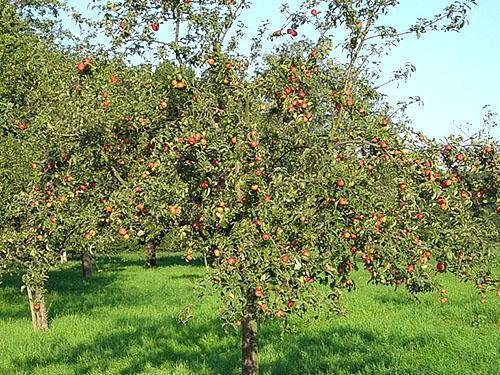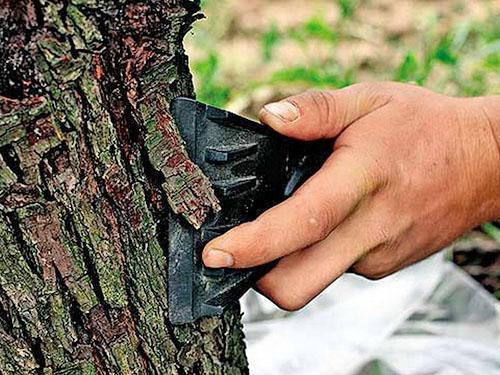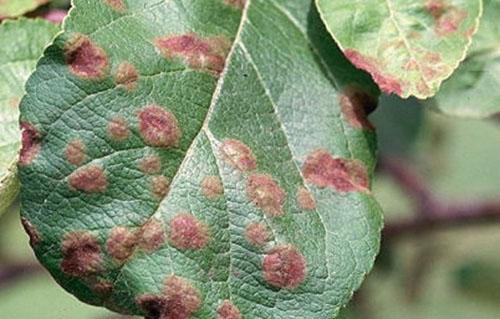It is important to know why the leaves of the apple tree turn black and dry
 It is difficult to imagine that an apple tree does not grow on a piece of land, even a tiny one. If it is a fruit-tree-friendly area, apple orchards become a source of income. But wherever this beautiful tree grows, diseases can overtake it. Why the leaves of the apple tree turn black and dry, why the tree dries up and what to do - there are questions to which there is an answer.
It is difficult to imagine that an apple tree does not grow on a piece of land, even a tiny one. If it is a fruit-tree-friendly area, apple orchards become a source of income. But wherever this beautiful tree grows, diseases can overtake it. Why the leaves of the apple tree turn black and dry, why the tree dries up and what to do - there are questions to which there is an answer.
Prevention

A garden only attracts eyes, arouses admiration when it is healthy. And the fact that it is easier to prevent a disease than to cure it applies not only to a person, but also to his green friends. From the very beginning of apple cultivation, you need to control its development.
When buying a seedling, you should make sure that the root system is well developed and there are no mold spots on the roots, the surface color is uniform. The vaccination site is noticeable. The stem has a uniform color, the bark is not damaged. Cleaning the leaves of fallen trees in the fall will prevent the spread of spores and other infections, it is best to burn the autumn garden leaves, and then use the ash as fertilizer.
Trimming and shaping the crown should be performed only with a disinfected tool, and the wounds should be immediately closed from the penetration of infection. A photo of apple tree leaf disease and their treatment will show the danger of non-compliance with hygiene requirements. In the spring, two fungicide treatments should be carried out with swelling of the buds and along a green cone. For mature trees, timely feeding is necessary, mulching trunk circle.
The tree will remain healthy only with proper care and will delight with decorativeness and harvest. Strict adherence to agricultural technology is the key to a healthy garden.
If all measures are taken, the apple tree can get sick in rare, especially unfavorable years. If you know the signs of the disease, upon examination, you can understand the cause of the yellowing of the foliage on the apple tree.
Diseases of apple trees
 The apple tree gets its nourishment from the roots and leaves. Therefore, the disease of any part of the tree, if left untreated, will lead to death. Why the apple tree is drying and what to do can be determined on the spot. There are different diseases that are transmitted:
The apple tree gets its nourishment from the roots and leaves. Therefore, the disease of any part of the tree, if left untreated, will lead to death. Why the apple tree is drying and what to do can be determined on the spot. There are different diseases that are transmitted:
- disputes;
- bacteria;
- viruses.
Scab
 In the spring, after the young leaves bloom, the appearance of oily specks on the young foliage will become noticeable. It's a scab on an apple tree. Over time, the spots on top are covered with a velvet bloom, then the entire plate becomes brown. That is why the apple tree leaves not only turn black and dry out at the height of summer, but the fruits are also affected by disease and become unfit for food.
In the spring, after the young leaves bloom, the appearance of oily specks on the young foliage will become noticeable. It's a scab on an apple tree. Over time, the spots on top are covered with a velvet bloom, then the entire plate becomes brown. That is why the apple tree leaves not only turn black and dry out at the height of summer, but the fruits are also affected by disease and become unfit for food.
 Scab is a fungal disease. Its spores winter on last year's foliage and penetrate the plant along a green cone, from the moment the young leaves appear. Slow leaf opening and warm rainy weather become a condition for implementation. In such conditions, the embedded spores germinate and create mycelium. Scab is most often affected by old trees with a thickened, poorly ventilated crown. Having developed, the disease first of all destroys the leaves, they turn black and fall off. The fruits are ugly or fall off when set.
Scab is a fungal disease. Its spores winter on last year's foliage and penetrate the plant along a green cone, from the moment the young leaves appear. Slow leaf opening and warm rainy weather become a condition for implementation. In such conditions, the embedded spores germinate and create mycelium. Scab is most often affected by old trees with a thickened, poorly ventilated crown. Having developed, the disease first of all destroys the leaves, they turn black and fall off. The fruits are ugly or fall off when set.
Fighting fungal diseases consists in adhering to agricultural techniques, repeated spraying with copper-based fungicides or their substitutes. All treatments are stopped 3 weeks before harvest.
Rust
 Another formidable fungal disease is rust. This disease manifests itself after the flowering of the apple tree. Orange spots appear on the leaves of the tree on the top of the plate. There are black dots on the spots, under them there are spore sacs, which open and shoot spores. The lower part of the leaf also gets a yellow spot at this point. In the future, the disease progresses, as seen in the photo. Diseases of the leaves of apple trees and their treatment is a process that requires patience.
Another formidable fungal disease is rust. This disease manifests itself after the flowering of the apple tree. Orange spots appear on the leaves of the tree on the top of the plate. There are black dots on the spots, under them there are spore sacs, which open and shoot spores. The lower part of the leaf also gets a yellow spot at this point. In the future, the disease progresses, as seen in the photo. Diseases of the leaves of apple trees and their treatment is a process that requires patience.
In addition to leaves, rust in a neglected state affects the fruits and branches of the tree. The fungus initially develops on juniper, and later, after overwintering on plant residues, falls on a leaf of a tree.
Therefore, the juniper in the garden must be treated against fungal diseases, often even without visible signs of rust.
 Rust can cause yellow foliage in apple trees. It also leads to fruit falling off and cracking of the bark on the trunk. At the first sign of rust, they begin to fight it. All infected leaves, shoots, fruits are immediately removed. The branches are cut a few centimeters below the infection site. Spraying is carried out with one of the preparations:
Rust can cause yellow foliage in apple trees. It also leads to fruit falling off and cracking of the bark on the trunk. At the first sign of rust, they begin to fight it. All infected leaves, shoots, fruits are immediately removed. The branches are cut a few centimeters below the infection site. Spraying is carried out with one of the preparations:
- based on copper - cuproxate, oxychloride, copper sulfate 1%;
- Zineba solution 0.4%;
- Topaz, Vectra.
Treatments are repeated at intervals of 2 weeks until the end of the season.
In order to prevent this formidable, and difficult to remove, fungal disease, a number of rules should be followed:
- the neighborhood of coniferous and fruit trees in the immediate vicinity should not be allowed;
- in early spring, before the start of sap flow, find the affected areas, clean them up to healthy wood, treat with a strong solution of copper sulfate 5 grams in half a glass of boiling water (5%);
- coat with garden varnish or special putty, then repeat the treatment with fungicides for prevention.
I wish you rich harvests and a healthy garden! Read why do the leaves of the apple tree turn yellow!